Growing Awareness and Education
Growing awareness and education regarding Burkitt lymphoma are pivotal drivers of the Burkitt Lymphoma Therapeutics Market. Increased efforts by healthcare organizations and advocacy groups to educate both the public and healthcare professionals about the symptoms and treatment options for this aggressive lymphoma are fostering a more informed patient population. This heightened awareness is likely to lead to earlier diagnosis and treatment, which can improve patient outcomes. Furthermore, educational initiatives are encouraging more patients to seek medical attention, thereby increasing the demand for therapeutic interventions. As awareness continues to grow, the market is expected to see a corresponding rise in the utilization of available therapies, contributing to overall market expansion.
Advancements in Precision Medicine
Advancements in precision medicine are significantly influencing the Burkitt Lymphoma Therapeutics Market. The integration of genomic profiling and molecular diagnostics allows for tailored treatment approaches that enhance therapeutic efficacy. As research continues to uncover the genetic underpinnings of Burkitt lymphoma, targeted therapies are emerging as a promising avenue for treatment. The market is witnessing a shift towards personalized medicine, with an increasing number of clinical trials focusing on specific genetic mutations associated with the disease. This trend not only improves patient outcomes but also drives investment in the development of novel therapeutics. The potential for precision medicine to revolutionize treatment paradigms in Burkitt lymphoma is likely to contribute to market growth in the coming years.
Rising Incidence of Burkitt Lymphoma
The Burkitt Lymphoma Therapeutics Market is experiencing growth due to the rising incidence of Burkitt lymphoma, particularly in regions with high prevalence rates. This aggressive form of non-Hodgkin lymphoma predominantly affects children and young adults, with an estimated incidence rate of 1 to 2 cases per million individuals annually. The increasing awareness of this disease among healthcare professionals and the general public is likely to lead to earlier diagnosis and treatment, thereby driving demand for innovative therapeutic options. As the understanding of the disease's biology improves, the market is expected to expand, with new therapies being developed to address the specific needs of patients. This trend suggests a potential increase in market size as more effective treatments become available.
Increased Funding for Cancer Research
The Burkitt Lymphoma Therapeutics Market is benefiting from increased funding for cancer research initiatives. Governments and private organizations are allocating substantial resources to understand the complexities of various cancers, including Burkitt lymphoma. This financial support is facilitating the development of new therapeutic agents and clinical trials aimed at improving treatment outcomes. In recent years, funding for cancer research has seen a notable rise, with billions of dollars being invested annually. This influx of capital is expected to accelerate the pace of innovation in the market, leading to the introduction of novel therapies that could significantly alter the treatment landscape for Burkitt lymphoma. As research progresses, the market is likely to expand in response to the growing number of effective treatment options.
Emergence of Innovative Treatment Modalities
The emergence of innovative treatment modalities is reshaping the Burkitt Lymphoma Therapeutics Market. Recent developments in immunotherapy, CAR T-cell therapy, and monoclonal antibodies are providing new avenues for treatment that were previously unavailable. These innovative approaches are showing promise in improving response rates and reducing relapse rates among patients with Burkitt lymphoma. The market is witnessing a surge in clinical trials exploring these novel therapies, which could potentially lead to breakthroughs in treatment. As these innovative modalities gain traction, they are likely to attract significant investment and interest from pharmaceutical companies, further driving the growth of the market. The potential for these therapies to change the standard of care for Burkitt lymphoma is substantial.


















Leave a Comment